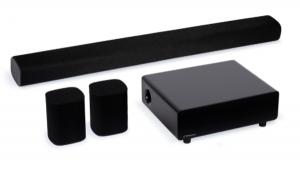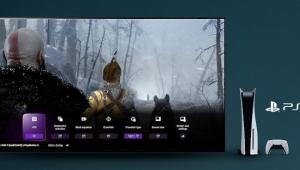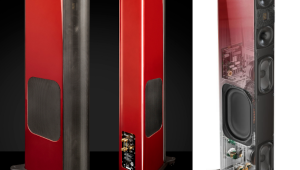Monster Cable Clarity HD Model One Page 2
To find out, I placed the Clarity HD pair on my usual speaker stands, linked them, plugged them into the wall, plopped my iPhone into the dock, and pressed Play on the credit-card-style remote supplied with the Clarity HDs. Steve Earle's "Someday" magically commenced, and it sounded terrific. Voices were naturally balanced, without any of the "honk" or "hoo" colorations most "desktop" speakers suffer (many egregiously), and they were supported by the dynamic effortlessness and "space" to transients like snare drum smacks that only well-designed active loudspeakers or high-end passive speakers with ample amplification achieve.
The Clarity HDs are a bit bright up top – probably deliberately so, to yield that sharply etched, "studio-monitor" sound. In the same vein they're also punchily dynamic in the pop-bass octaves (50-200 Hz), making them just right for the most widely listened-to kinds of music. In fact, the Model Ones remind me a great deal of several prosumer powered monitors of the sort that recording pros and semi-pros place on the meter bridges of their consoles (and over which a number of surprisingly big-name albums have been produced).
That said, even the "0 dB" setting of the Clarity HDs' back-panel tweeter control sounded a bit bright in my setup; the -2 dB setting, while still definitely "forward" on the top few octaves, was just about right. The +2 dB setting was brighter still, of course, but still not painful, "spitty," or harsh, suggesting a generally smooth tweeter response, but a somewhat enthusiastic level-set.
But with the switch at -2 dB, and the Model Ones toed in a bit past on-axis, balance was nearly ideal. The Monsters delivered highly detailed sound, including impressively musical massed strings and full-orchestral playback, and produced a very well-arrayed stereo soundstage.
At the other end, the Model One's bass reached well below an honest 50 Hz, and delivered at least some musically useful output rather lower than that – this is impressive for so relatively compact a 6.5-inch two-way. The secret: one of the many advantages of powered loudspeakers is that designers can ideally match woofer-amp and driver, and build in EQ to extend response beyond what would otherwise occur.
The tradeoff is level, and indeed in my large-ish room (about 2,900 c.f.) the Clarity HDs audibly speed-bumped a notch shy of earplugs-required settings, with an obvious decrease in bass power, slightly "smooshed" transients, and faintly glazed vocals and instruments.) But don't get me wrong: the Model Ones yielded plenty of clean, dynamic level for truly rocking, conversation-made-difficult playback. (Monster does not specify the onboard amplifier's power output.)
In short, Monster's Clarity HD Model Ones are very capable indeed, if a bit expensive; you could spend the same money on passive components (say, an NAD C-316BEE integrated amp and a PSB Image B5 bookshelf pair) and come out about the same, both price- and performance-wise.
But that makes no mention of the Monsters' portable convenience factor, compactness, or its iPod/Phone dock. Nor their versatility: The Clarity HD makes a super monitor for an iPhone guitar rig (I just spent a happy hour playing my Strat through them via my favorite, the AmpKit app), and an even better keyboard monitor -- they sounded remarkable powering my old Kurzweill PC-1x, with plenty of power and just enough extension for satisfyingly full piano reproduction. And all the inputs automatically mix if signal is present, so you could jam with friends on the spot.
So Monster's Clarity HDs wear multiple hats, and wear them very well indeed. So do several of the aforementioned prosumer powered-monitor models from companies like M-Audio and Mackie Designs – minus the dock. But for now, in the "consumer space," the Clarity HD is a unique solution - and as an iPod dock is is at, or very near, the top of the heap.
- Log in or register to post comments



















































